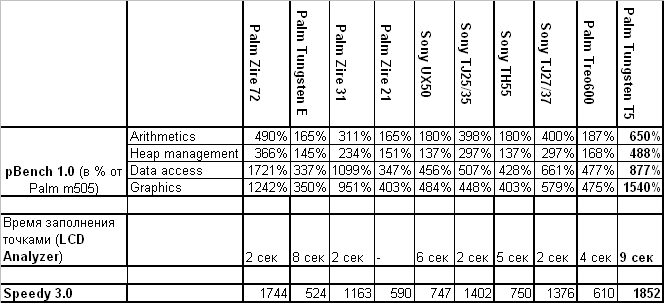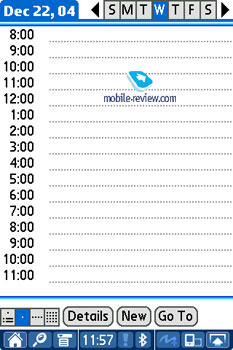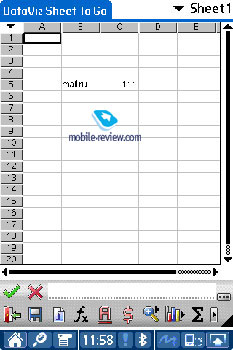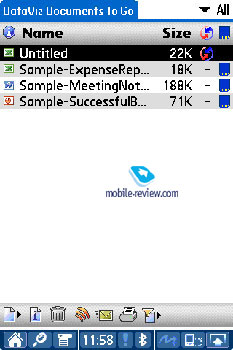|
|
Review of PDA Palm Tungsten T5 and results of the year for Palm
Standard kit:
- PDA
- Charger
- Screen cover
- Manual
- Two disks with software
Live pictures

The destiny of Palm OS platform
When we see how fast Pocket PC platform is gaining popularity,
the results shown by Palm OS do no longer impress much. The platform
that used to be the only leader on the PDA market ended 2004 in
the red. 3 key events determined this state of things:
- The largest maker of Palm OS devices, Sony has left the world
market. Many users switch to the rival platform. Virtually palmOne
turns to be the only maker of Palm OS devices. The inter-platform
competition comes to naught.
- There wasn't introduced a device powered by Palm OS Cobalt 6.
The public has been waiting for the release of devices based on
the new operating system for more than a year, however still in
vain. Besides in the end of the year palmOne said, probably there
would be no such devices till 2006 in the market.
- The 3Q 2004 for Palm OS platform is one of the worst in company's
history. For the first time Pocket PC platform outpaces Palm OS
with the devices sold, the result of 2004 marked the loss of the
leadership for Palm OS.
Is it everything that bad and Palm OS is going down? What will
happen to the platform? PalmOne and Palm Source seem to care little
about the lost leadership in the market and technological gap. Palm
OS can last for a year or a year and a half on the old operating
system, high popularity in the masses (especially in the US) and
popular trademark.
- palmOne announces the most favorable 2Q of the financial year.
The sales made up $376.2 million, the net profit - $24.7 million
(a tenfold rise compared with the same period the year before).
- PalmSource also announces favorable 2Q of the financial year.
The sales volume amounted to $19.2 million and the net profit
- $2.1 million (in the same period the year before the company
had $9.1 million losses).
- palmOne reports on record sales of Palm Tungsten E (each 5th
PDA sold in the US) and the Palm Zire series. Treo communicators
enjoyed high sales (in the US), but that's another story.
Well, the lion's share of Palm OS devices falls on the US market,
the demand here is inertial, and we come across a traditional devotion
to Palm. However palmOne realizes this situation can't last for
long, sooner or later if the company doesn't take reasonable steps
and proceeds with old technologies only, the US market will be switched
to Microsoft platform. 2005 will be the crucial year for Palm: the
platform will either lose its leadership for some long time (I don't
feel like writing - forever, but this can happen) or will try to
restore it, or at least not to remain far behind.
Let's try to view possible scenarios for 2005.
Negative scenario:
- Palm OS Cobalt devices are postponed till 2006.
- There appear updated models in the current line, let
them be called Palm Zire 32, Palm Zire 73, Tungsten E2. The Tungsten
T series is followed by models slightly differing from T5, Wi-Fi
support added (the main distinction). Other handhelds also differ
slightly (a bit larger memory size, better screen in junior models,
new processors, 2-megapixel cameras).
- The Palm Treo series still runs Palm OS.
- Companies report more frequently on financial successes: no
substantial investments into R&D, debugged quality control at
the production of devices on the old platform (lower costs of
warranty services), wide margin between the cost and retail prices
(it's possible when there are no inter-platform competitors at
all).
- The developer of the software platform part, PalmSource won't
succeed in finding strong partners to replace Sony in a way. The
existing partners (Samsung, the Chinese giant Lenovo) do not figure
on Palm OS seriously, they hold the patent to be on the safe side.
Result: greater market share loss, especially
in Europe. Some users of Palm OS devices can't wait any longer and
switch to Windows Mobile devices. There are other adverse factors
for Palm OS devices: the future release of Windows Mobile 2005 (the
code name - Mantego), price cuts on top Pocket PC devices followed
by the tough competition, restricted model line of Palm OS devices.
Positive scenario:
- The model based on Palm OS Cobalt will be available in the first
half of 2005, it will combine the VGA-screen, dual integrated
wireless adapters Wi-Fi and Bluetooth.
- The software compatibility matters with new OS are settled down
quickly with the release of the software specially designed for
new OS.
- The rest of the line is also updated with devices based on Cobalt.
- The Palm Treo series is shifted to Windows Mobile using a development
solution by the Taiwanese company HTC.
- PalmSource finds the alternative to Sony, which is no longer
on the world market.
Result: the platform goes on competing with Windows
Mobile. The technical gap is eliminated in users' eyes. Although
the platform won't be leading till the end of 2005 because of its
restricted model line.
Naturally, we pictured the extremes, the reality will be somewhere
in between. The plans of palmOne are closer to the positive scenario,
but they depend much on the readiness of Palm OS 6 device and on
the results of the 3d financial quarter 2005. The fact that PalmSource
announced the course to Linux platform shows that the developers
realized they were unable to develop new OS versions on term (there
is no other explanation to this long suspension of devices based
on Palm OS Cobalt). I'd say one more time, 2005 will be the crucial
year for Palm.
Tungsten, Zire, Treo
The current product line of palmOne is divided into 3 groups. The
first group includes Zire products, which are low-end
solutions equipped with organizer and multimedia functions. The
sub-brand Tungsten deals with "serious" and advanced
PDAs designed for business users. And the Treo represents smartphones.
Right after the announcement Palm Tungsten T5 roused the tide of
negative critics among reporters and ordinary users. Before the
release it had been rumored that the model would be powered by Palm
OS 6 and have dual wireless adapters, VGA screen and QWERTY-keyboard.
Imagine how the public was surprised to see an inferior version
of the Tungsten T3 instead of the technological flagman model. The
device lacked a slider keyboard (a distinguishing feature of Palm
Tungsten series), a voice recorder and LED indicators on the shell.
The positive change touched upon an extended battery. As a matter
of course there were no Wi-Fi modules or VGA screen. But still,
let's have another look at the situation.
PalmOne just had no time to prepare the real Palm Tungsten T5 based
on Cobalt. Besides it was the high time for the company to announce
the top model of the line. As a result the company decided to reequip
Palm Tungsten E2 into Palm Tungsten T5 quickly and add a unique
function (built-in USB flash drive).
In our review we'll try to minimize the comparison with the Tungsten
T3, for Palm Tungsten T5 is not the real TT5, but the renamed Tungsten
E2 meant to close the gap in the model line by palmOne.

Built-in USB Flash Drive
The unique feature of the T5 (according to company's marketing
specialists it should draw attention to the handheld) is the capability
to work as a USB-flash drive without any extra software, like in
case with common USB-flash trinkets, which became very popular.
Let's try to find out whether it is that unique and necessary.
The available Flash memory makes up 161 MB, you can store anything
on it and then work with the files on the handheld or just use it
to transfer files. If the handheld has a SD or MMC card inserted,
the card becomes accessible as a flash disk. Besides the largest
memory size for the SD card has already reached 2 GB, and the price
for the 1GB SD card has dropped to $90, the 128 MB SD card - $15
or less.
It's clear with memory size, now let's pass over to the speed.
There is an alternative to the built-in flash - the high-speed USB
2.0 reader 12-in-1 (it costs some $20) and the 1 GB SD Transcend
45x card. This pair works also without drivers. We ran tests with
the Aida32 package. These are the results:
|
Palm TT5 Flash |
Palm TT5 SD |
Card Reader SD |
Read |
0.64 Mb/s |
0.54 Mb/s |
9.63 Mb/s |
Random Read |
0.64 Mb/s |
0.55 Mb/s |
8.39 Mb/s |
Access Time |
3.1 ms |
4.8 ms |
1.1 ms |
Write |
- |
0.44 Mb/s |
2.03 Mb/s |
There is nothing to comment on here, everything's clear enough.
I'd only note that the lag of the integrated flash is due in most
part to restrictions of USB 1.1 standard.
The real price for this peculiarity of the T5 is about $35 (a card
+ a reader make less price difference than that between the T3 and
the T5), low speeds, no need to take the reader with you. In result,
we have a nice feature, but it can be the decisive factor when you
buy a PDA, just another plus.
Package
I was a little bit surprised when I saw no cradle in the standard
kit, after all it was supplied with the Tungsten T3. However, if
we remember the Tungsten E without a cradle in the kit, the matter
becomes clear.
Instead of the cradle there is a USB-cable with the HotSync button.

The protective flip cover is mounted on the left. I liked it -
it coped well with its functions, it protects the screen from being
damaged. It looks expensive and feels pleasant to touch. There is
a major flaw with it - when placed in the pocket, it turns to press
buttons and the joystick, the T5 needs badly Hold button, an essential
element in Sony handhelds.

Design, control elements
Design of the Tungsten T5 is inherited from the Tungsten E, the
resemblance is obvious. The Graffiti zone is replaced by the virtual
analog, the casing got darker. As for weight and dimensions, they
are average, considerably larger than in the T3 with the slider
shut and thinner than a dual slot Pocket PC.
- Palm Tungsten T5: 121x78x15 mm 146 g
- Palm Tungsten T3: 109x76x16 mm 156 g
- Palm Tungsten E: 115x78x12 mm 131 g
The shell is made of plastic, which feels metallic. In all, the
handheld feels comfortable in hand.

The application buttons and the joystick under the screen prove
to be comfortable while handling documents and games. In all, they
have no flaws; they are well positioned and have optimal size. I
found them fully identical with the analogs in the Tungsten E. As
in case with the Tungsten E there are no LED indicators above the
screen, besides other control elements are located at sides.
There is nothing on the left and the right sides, a voice recorder
button could have gone here.
A look at the top reveals traditional elements: the SD/MMC slot,
standard audio jack (I'd mark the excellent sound during the MP3
playback), the power button and the silo. There are two points in
the assessment. Firstly, the power button creaks when pressed (it
might be a problem of the particular specimen). Secondly, I'd mark
the stylus - its size and weight are optimal for use. However, it
is just like the stylus on the Tungsten E…

At the back panel we find a loudspeaker and a reset pin hole (unscrew
the stylus to tip it).
The bottom hides the Multi-Connector and nothing special.
Screen
The screen in Tungsten T3 has a 320x480 (HVGA) resolution, in the
middle between QVGA and VGA screens for Pocket PC (picture quality
and screen size). It is comparable with that of T3 - the same size,
good color rendering, performance under the sunlight, excellent
viewing angles. This is one of the best among Palm devices, however
it yields greatly to top Pocket PC models with VGA screens.
Productivity, specifications
There are 53 MB of RAM available onboard; this is more than enough
for Palm OS.
The heart of the handheld is its new Intel XScale PXA270 processor
working at 416 MHz. Subjectively it is at the same level with the
T3, everything runs as quick, you'll hardly notice a difference.
The synthetic tests revealed some peculiarities, i.e. some strange
graphic test results (long time in drawing dots with LCD Analyzer
along with high graphic test results in pBench). The developers
might have tried to optimize the operating system to Wireless MMX
technology, which is built in the new Intel processor.

The only reprimand to the speed arises during the reset, which
lasts for some dozens of seconds.
Battery life
The PDA comes with the non-removable battery capacious of 1300
mAh, that's much higher than 900 mAh in Tungsten T3. The battery
life has increased correspondingly. Under the maximum load (video
playback, the highest backlight level) the T5 worked for some 3
hours till the first alert of battery low level. In the MP3 mode
with the screen off (the playback in pTunes from the memory card,
system alerts ignored) the battery got drained out after 11 hours.

Bluetooth
We can compare the work of Bluetooth in Tungsten 5 with Palm Zire
72, the opportunities are identical. That is the handheld featuring
best Bluetooth opportunities among all Palm OS devices, but still
lags behind Pocket PC.
At the bottom of the screen you see the status bar with icons,
which facilitate the work with the PDA.


From left to right: House -resumes the list of applications, tap
it to see the list of frequently used applications; Magnifier -
ordinary search engine; Menu - launches menu in any application;
Clock - displays current time, tap it to see the battery power left,
available memory, the level of backlight and sound (the photo below);
Bluetooth icon stands for Bluetooth activity; Exclamation mark -
a prompt in different applications.

As a matter of fact there aren't serious changes in the software
compared with Palm Tungsten T3, so we won't go into details here.
 

The built-in personal information manager (PIM), the same as in
the T3.


 
DataViz Document To Go. A powerful package to
edit original MS Office documents without the preliminary conversion.

Files. An integrated file manager.

Media views photos.
In Russia the device is available for sale with the russificator
by Paragon (Russian interface, text input in the Russian, Russian
fonts, partial compatibility with Russian MS Office documents).
Conclusion
If we treat Palm Tungsten T5 as the successor of Palm Tungsten
T3, then I'd say it failed. There is nothing fundamentally new about
it, some functions and the kit are cut. The unique integrated flash-drive
adds to the functionality, but this is hardly a big reason to buy
T5. You can replace your T3 with T5, if you do not care much about
the money spent on it and you are not satisfied with the battery
life of T3.
As a matter of fact Tungsten T5 is a successor of Tungsten E2;
you can see it even with the naked eye. The latter costs $200, while
T5 is twice as more expensive. For that price difference the user
gets Bluetooth, HVGA screen, and built-in flash-drive. That's all.
However, the price for Palm Tungsten T5 can be considered too high,
as I have already said, the model has no direct rivals, that means
it will be sold. But we still expect to see the real successor of
Tungsten T3 based on Palm OS Cobalt in 2005.
Description
- Class: business
- Rivals: Palm Tungsten T3, Sony TH55
- Processor: Intel XScale PXA270 416 MHz
- Operating system: Palm OS 5.4
- RAM available: 52.6 MB
- Flash memory available: 161 MB
- Screen: 320x480 dots (active zone 79x53 mm, 3.74" diagonal),
transflective, 65K colors
- Connectivity: SD, MultiMediaCard, SDIO memory cards, IrDA, Palm
Universal Connector, Bluetooth
- Battery: non-removable Li-Ion 1300 mAh
- Dimensions: 121x78x15 mm
- Weight: 146 g
Anton Kotov
(anton.kotov@mobile-review.com)
Translated by Anja Rytchkova (anja.rytchkova@mobile-review.com)
Published — 22 January 2005
Have something to add?! Write us... eldar@mobile-review.com
|
News:
[ 31-07 16:21 ]Sir Jony Ive: Apple Isn't In It For The Money
[ 31-07 13:34 ]Video: Nokia Designer Interviews
[ 31-07 13:10 ]RIM To Layoff 3,000 More Employees
[ 30-07 20:59 ]Video: iPhone 5 Housing Shown Off
[ 30-07 19:12 ]Android Fortunes Decline In U.S.
[ 25-07 16:18 ]Why Apple Is Suing Samsung?
[ 25-07 15:53 ]A Few Choice Quotes About Apple ... By Samsung
[ 23-07 20:25 ]Russian iOS Hacker Calls It A Day
[ 23-07 17:40 ]Video: It's Still Not Out, But Galaxy Note 10.1 Gets An Ad
[ 19-07 19:10 ]Another Loss For Nokia: $1 Billion Down In Q2
[ 19-07 17:22 ]British Judge Orders Apple To Run Ads Saying Samsung Did Not Copy Them
[ 19-07 16:57 ]iPhone 5 To Feature Nano-SIM Cards
[ 18-07 14:20 ]What The iPad Could Have Looked Like ...
[ 18-07 13:25 ]App Store Hack Is Still Going Strong Despite Apple's Best Efforts
[ 13-07 12:34 ]Infographic: The (Hypothetical) Sale Of RIM
[ 13-07 11:10 ]Video: iPhone Hacker Makes In-App Purchases Free
[ 12-07 19:50 ]iPhone 5 Images Leak Again
[ 12-07 17:51 ]Android Takes 50%+ Of U.S. And Europe
[ 11-07 16:02 ]Apple Involved In 60% Of Patent Suits
[ 11-07 13:14 ]Video: Kindle Fire Gets A Jelly Bean
Subscribe
|



















